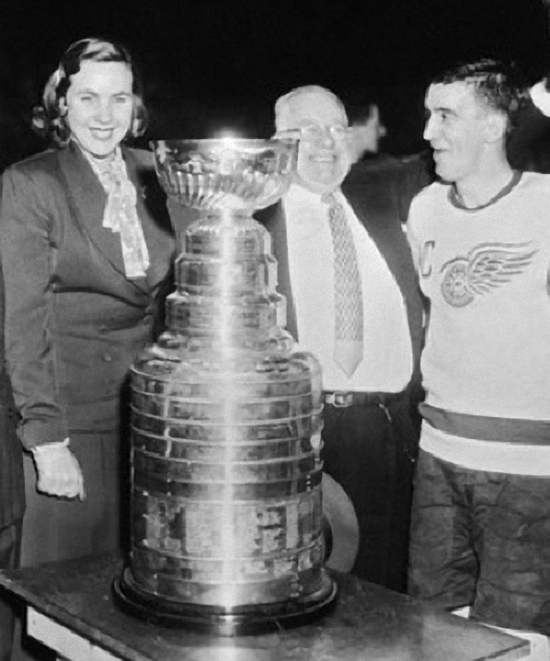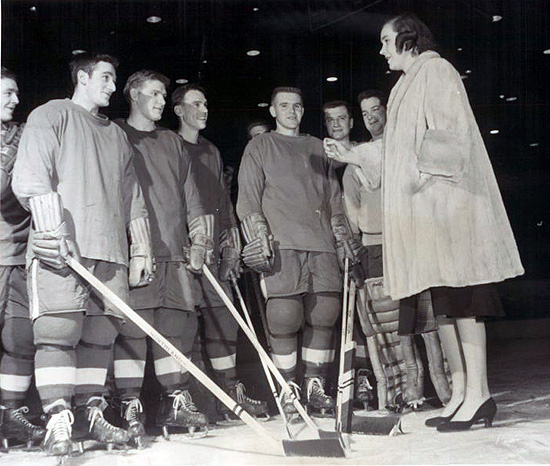Candidates for election as Honoured Members in the builder category shall be chosen on the basis of (i) their coaching, managerial or executive ability, where applicable, or otherwise any significant off-ice skill or role, (ii) their sportsmanship and character and (iii) their contribution to their organization or organizations and to the game of hockey in general.
The next person I want to make a case for election to the Hall of Fame as a builder is someone who is not talked about very often. Part of what I want to do here is discuss those who changed the way aspects of the game are perceived, not just wins, losses or Stanley Cups. With this in mind, I hope to expand those who should be considered as a candidates for the Hockey Hall of Fame by exploring the game’s history. In this case, the candidate I am proposing is Marguerite Norris of the Detroit Red Wings Hockey Club in the builder category.
When James Norris died in 1952, there was a lot of confusion about the future of three of the NHL’s clubs. The Norris family over the years had found its way into taking the majority shares of the Chicago Black Hawks, Detroit Red Wings, and New York Rangers. Prior to James’ death, the only team that he owned outright was the Detroit Red Wings. That team was his “baby” and that is where his focus for success was. However, he also had shares in Madison Square Garden, which owned the New York Rangers. He had purchased enough shares of that stock so that he had the most of any individual, but not enough for majority control. Had he been had majority control of the Rangers, he would have broken NHL by-laws that prohibits one person from owning two teams.
Then there was the case of the Chicago Black Hawks. The Hawks were owned by Fredric McLaughlin up until his death in 1944. However, Chicago Stadium was owned by James Norris. After McLaughlin died, a syndicate led by Bill Tobin took over, but he was known to be just a figurehead for James Norris himself, the money behind the syndicate. When James realized his health was failing him, he went to put his affairs in order. What he ended up doing is gave his two eldest sons and half-brothers, Jimmy and Bruce control of the Black Hawks, while splitting up the Red Wings equally amongst his entire family. It was not publicly known that Jimmy and Bruce were running the Hawks, but the other team owners knew who was running the team.
When James Norris died, as far as the public knew, Bill Tobin was the governor for the Chicago Black Hawks with private ownership behind him. Seeing an opportunity, Conn Smythe, owner of the Toronto Maple Leafs, brought up publicly that he didn’t know who the owners of the Black Hawks were. After much resistance from the NHL to make that public knowledge, eventually Jimmy and Bruce Norris announced that they had bought the majority shares of the Hawks. Jimmy had the majority share due to Chicago’s influence in boxing and wanted to make sure he had control of Chicago Stadium for that reason. What this did for Smythe was ensure that neither of those two Norris brothers could take over the Red Wings, giving Smythe more power in the Board of Governors for the NHL.
With the “crown jewel” (Red Wings) of the Norris Empire still without a sole leader, Jimmy Norris had to make a decision on who to back to take control of the Wings. According to the book “Networth”, he considered convincing Bruce Norris to sell his shares of the Hawks so he could take over, but he felt that Bruce was too hard to control. So 10 days after James Norris died, his 24 year old daughter, Marguerite took over as President of the Red Wings, making her the first female executive in NHL history.
The problem with Jimmy’s decision here is that Marguerite wasn’t easy to control either. She was already known within the Norris household as being too much like her father than their parents would have wanted. According to her, “I was supposed to be a debutante and marry a Vanderbilt boy”. Instead, she left home and moved to New York on her own, unheard of in the 1950s, and got a job with Dun and Bradstreet, a firm that supplied reliable, objective credit information.
From this, one gets the sense had she had been a man, she would have likely taken over the Norris Empire without any issues. She had the business knowledge to handle herself in that world, and travelled with her father enough to know how the hockey world worked.
Once Marguerite took over the Wings, she kept control of the team the way her father used to. Much to the chagrin of both, she completely oversaw what General Manager Jack Adams did on the hockey side and Lincoln Cavalieri did on the running of the arena. Adams even commented on this by saying, “When I kept calling her ‘honey’ and ‘dearie’ my wife asked if that was a dignified way to address our now president….I said, ‘How can I be dignified with a youngster I trotted on my knee when she was five years old?’”. Marguerite wasn’t a fan of Jack Adams and attempted to remove him and put Tommy Ivan in charge of the team. Ivan, However, wasn’t willing to wait for Adams to retire and he went on to build Jimmy’s Chicago Black Hawks.
Of course the sexism aspects of her taking the job were not going to go away in the 1950s. When she took over as stated in “Networth”, newspapers were more concerned about how she was going to redecorate the President’s office than how she was going to run the team. As well, Conn Smythe with his new found power tried humiliate her, in which he cited “a non-existent NHL by-law forbidding women from holding that position (governor). Marguerite deftly turned it around by appointing Smythe’s rival Jack Adams in her place, and communicated her votes with hand signals.” Smythe apparently continued to try to embarrass Marguerite by commenting on how badly maintained the women’s washrooms were at the Olympia Stadium and it wasn’t until Marguerite mentioned to a reporter that Smythe was obsessed with her women’s washrooms that he backed down.
 Margurite Norris with Jack Adams and Ted Lindsay
Margurite Norris with Jack Adams and Ted Lindsay
By 1952, Jimmy Norris realized that there was no chance that he could ever take over the Red Wings. He did not get along with his step-mother, whose vote he would need in order to gain control of the Wings. So cutting his losses, he made a deal with the rest of the Norris family by selling his shares of the Red Wings and in return the Norris family would sell him their shares of the Black Hawks making Jimmy sole owner of the team. What this did also freed up Bruce Norris to have control of an NHL team as his shares of the Black Hawks were also sold. In 1955, Bruce announced his intentions to run the Detroit Red Wings.
By this point, Marguerite Norris had been running the team for 3 years with great results. In the 3 years with her at the helm the Wings captured two Stanley Cups making her the first female to have her name officially engraved on the Cup. She did not want to turn over control of the club to her brother, however, as she did not trust him to do a good enough job. Marguerite felt that he would not be able to control Jack Adams’ emotions with the players enough see the big picture. As well Bruce had been known for getting into business with some questionable characters. She needed the votes of the rest of her family to retain control, however, but like Jimmy quickly found out that her mother was not going to side. This resulted in her being forced to give up control of the team as president to Bruce Norris while continuing to have a role with the team as vice-president which remained the case until 1957.
Those who know the history of the NHLPA may recognize that year as when Wings’ captain Ted Lindsay was traded from the Detroit Red Wings to the Chicago Black Hawks as punishment for attempting to start up a union. In order to make this trade, Bruce Norris would have needed to get the approval of the rest of his family, however he didn’t bother to do so. At this time Marguerite was still the vice-president of the team and didn’t hear about it until she read it in the papers. This is how she tells the story in the book “Networth”.
Livid, she grabbed the phone and dialled her brother, Bruce. “You can’t do that!” she exclaimed. “Well I’ve done it,” he replied unperturbed. “You just can’t do that!” she repeated louder. “Do you want to have a fight about it in the papers?” he challenged. Marguerite paused for a moment, then offered a limp “No” before dropping the phone into its cradle.
Today, Marguerite acknowledges that she might have won had she accepted Bruce’s challenge. But the prospect of dragging the Norris name into the papers for a family feud appalled her… Furthermore, her mother who had always disapproved of Marguerite’s independent spirit would have sided with Bruce. A public war might have destroyed the already fragile relationship between mother and daughter.”
After the phone call, she realized her career with the Red Wings had ended.
Had Marguerite Norris fought with her brother and won, that may have changed the entire course of the NHLPA’s history. Ted Lindsay’s leadership and voice would have remained in the Red Wings’ dressing room and Bruce Norris and Jack Adams would not have been able to convince the rest of the team that Lindsay was only out for himself. In turn, one could look at that and say that if the NHLPA got off the ground then, Alan Eagleson would not have gotten into power a decade later and a lot of players, including Bobby Orr would not have been victimized.
 Marguerite Norris talking with the Red Wings team during practice
Marguerite Norris talking with the Red Wings team during practice
With all that said, neither of her brothers, Jimmy or Bruce, were ever able to match the success that she had as president of the Red Wings. Both Norris brothers are in the Hall of Fame, along with her father James. In her five years as an executive, Marguerite rose above all those who tried to undermine her until it was her own family that did so. As mentioned she was the first female executive in the NHL and the first woman to officially have her name on the Stanley Cup. Her name will forever be known as a success in the NHL and help pave the way for other women to lead their teams later.
Right now, there are only three women inducted into the Hockey Hall of Fame. They are Angela James and Cammi Granato, who were both inducted as players in 2010 and Geraldine Heaney who was inducted last year (2013). Right now there is no female inducted as a builder. Despite the limited time Marguerite spent with the Wings, however, she managed to achieve all the criteria that the Hockey Hall of Fame looks for as a builder. The Selection Committee would be hard pressed to find another candidate as qualified as her.
If anyone has any comments or ideas on who should be in the Hall of Fame, feel free to contact me in the comments section, through email at
[email protected], or through Twitter @Kirshenblatt.

